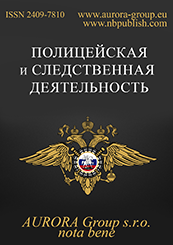The police and the institutions of civil society
Reference:
Zubenko, E.V., Lobunents, E.S. (2017). Topical Issues in Terms of Extending the Scope of the Institute of Jurors in District Courts. Police and Investigative Activity, 2, 1–6. https://doi.org/10.25136/2409-7810.2017.2.22909
Abstract:
The subject of the reserch is objective patterns of the procedure of hearing a criminal case in district courts with the participation of jurors, activity of bodies of judicial system, bodies of prosecutor's office, preliminary investigation connected with preparation of consideration of criminal case in district courts with participation of jurors. The purpose of the present article is to analyze organizational problems which can result from participation of jurors in district courts. The authors touch upon a number of certain problems caused by participation of jurors requiring complex solutions. The methodological basis of the research involves a dialectic research method and a system of general and specific research methods. The authors have used general research methods such as historical, statistical analysis, observation, comparison, analysis, synthesis, etc. The main conclusions of the conducted research is that appearance of jurors in district courts involves a number of certain problems which need to be solved in a complex. On the one hand, it is necessary to prepare technical capabilities of participation of jurors, and on the other hand, officials, for working in new conditions. At the same time appearance of jurors in district courts will provide access for citizens to justice and increase quality of training and considerations of criminal cases in court.
Keywords:
training, justice, prosecutor, investigator, state accuser, district court, jurors, activity, citizen, legislator
The police and criminal procedure
Reference:
Brusentseva, V.A. (2017). About Some Aspects of Interrogation Tactics of Underage Victims of Sexual Crimes. Police and Investigative Activity, 2, 7–13. https://doi.org/10.25136/2409-7810.2017.2.22484
Abstract:
The article is devoted to certain aspects of interrogation of underage victims who have been undergone subjected sexual violence. Special attention is paid to the participation of a psychologist in the production of this investigative action, and establishment of psychological contact with the victim of the crime. The subject of the research is the patterns of choice and application by the person conducting the preliminary investigation, tactical methods of interrogation of underage victims of crimes against sexual inviolability. The object of the research is the organization and tactics of underage interrogation. The general and special research methods have been used in the work including: system-structural method, comparative method, formal-legal method, and statistical method. The author concludes that during the interrogation it is necessary to take into account the age, specific features and the level of psycho-sexual development of a child. The recommendations on the organization of interrogation of minors, victims of sexual crimes of various age groups nave been formulated. The order of interaction between a investigator, underage victim and psychologist is described.
Keywords:
psychological contact, tactics of interrogation, psychosexual development, crime victim, minor, sexual inviolability, sexual crimes, psychological defence, conflict, psychological influence
Forensic activities and police work
Reference:
Morozov, V.V. (2017). Criminalistic Analysis of the Concept 'Economic Crimes Committed with Use of the Computer Equipment and Modern Information Technologies'. Police and Investigative Activity, 2, 14–25. https://doi.org/10.25136/2409-7810.2017.2.23035
Abstract:
The author of the present article analyzes essential features of the concept "economic crimes committed with use of the computer equipment and the modern information technologies". For this purpose the author studies current approaches to the definition of "economic crimes", and specifics of making crimes with use of the computer equipment and modern information technologies in the sphere of economic relations (production, distribution, exchange and consumption of goods and services as well as products of labor). The author states that the purpose of using these technologies is to facilitate commission of crime and conceal traces of crime, thereby complicating activities for detection and disclosure of the specified category of crimes. The methodology of the research invovles general research methods such as analysis, synthesis, comparison, induction, deduction, and specific research methods, in particular, system-structural and statistical analysis. The main conclusion of the article is the author's definition of "economic crimes committed with use of the computer equipment and the modern information technologies" as socially dangerous acts committed in the sphere of production, distribution, exchange and consumption of goods and services as well as products of labor by using a set of methods of storage, transmission, processing or destruction of computer information and hardware and software systems for the purpose of facilitation of commission of crime and concealment of its traces.
Keywords:
ways of commission of crime, identification of crimes, traces of crime, computer information, information technologies, computer equipment, economic crimes, formation of traces, essential elements of offense, criminalistic significant information
Police staffing
Reference:
Kuzina, N.V., Sulimov, K.T. (2017). Universal Odor Detector: On Creating the Genetic Resources of Domestic Service of Search Dogs. Police and Investigative Activity, 2, 26–51. https://doi.org/10.25136/2409-7810.2017.2.20520
Abstract:
The object of the research is the method for selecting and breeding as well as training search dogs. The subject of the research is the algorithm for developing and supporting the genetic resources of search dogs of hybrid populations like Laika reindeer herding and European jackal. The research and implementation of the practice of creating the genetic resources and developing the algorithm for selecting and training Laika reindeer herdings and European jackals has been done by the author for over thirty years. In this research the author has used the historical analysis (origin and development of domesticated dog and the problem of the reverse mutagenesis in the animal world), genetic analysis (the influence of jackals on features of domesticated dogs in the process of cross breeding), particularities of inheritting working features of dogs (in particular, their manifestation under different cross breeding conditions), experimental method (testing olfactor features of dogs in practice and work). The author has also used the descriptive and classification approach to analyzing the current list of breeds used in search activities (for example, dog security service at Aeroflot). The author offers the algorithm for creating the genetic sources of a universal search dog from Laika reindeer herding and European jackals, describes and classifies current genetic resources (owned by Aeroflot), and provides methods for testing dogs depending on their working abilities as well as methods for bringing up and training universal search dogs based on available genetic resources. These dogs have a highly developed intuition and can become universal official search dogs. Describes the tragic fate of the small size stock huskies in Russia, ways of their hybridization with the jackal and the available population.
Keywords:
fox terrier, quadroon, half-breed hybrid, Sulimovs dog, Laika reindeer herding, European jackal, reverse mutagenesis, assessment of the exterior, interbreeding, genetics
Questions of current interest
Reference:
Badal'yants, A.N., Stepanenko, V.V. (2017). Procedural, Institutional, Psychological and Linguistic Properties of Interaction Between Law Enforcement Officials and Hearing-Impaired Citizens. Police and Investigative Activity, 2, 52–59. https://doi.org/10.25136/2409-7810.2017.2.20960
Abstract:
The subject of the present research is the standard procedural, institutional, psychological and linguistic grounds of developing policemen's skills in communication with hearing-impaired citizens using dactile and sign language. The authors examine problems arising in the process of professional communication of law enforcement officials with hearing-impaired citizens. In order to solve these problems, law enforcement officials need to perform actions aimed at creating relevant conditions and psychological grounds for efficient communication. According to the author of the article, a policeman needs to define the main representational system of an individual and maintain a contact based on this system. The methodological basis of the research is the dialectical research method. The systems and activity approaches used by the author as the main direction of research methodology have allowed to analyze procedural, institutional, psychological and linguistic properties of interaction between law enforcement officials and hearing-impaired citizens from the point of view of certain patterns and interactions typical for their structural elements. The main conclusion of the research is that a policeman can maintain a psychological contact with a deaf or hearing-impaired citizen (i.e. situation of mutual understanding and overcome communication barriers in order to obtain information or perform actions that would be beneficial for achieving professional tasks) only if he or she manages to fully switch to the visual or kinesthetic information channels.
Keywords:
deaf, behavior, barriers, means, psychology, gesture, dactylology, communication, non-verbal, disabled
Questions of current interest
Reference:
Zyryanova, E. (2017). Topical Issues of Inquiry Division Chief Exercising Powers to Eliminate Procedural Defects Made by an Inquirer at the Pre-Trial Stage. Police and Investigative Activity, 2, 60–66. https://doi.org/10.25136/2409-7810.2017.2.21968
Abstract:
The author of the present article analyzes powers and competences of a chief of inquiry division to eliminate procedural defects made by an inquirer at the pre-trial stage. The author analyzes different points of view regarding the terms 'powers' and 'functions' applicable to criminal procedure law. Zyrianova emphasizes the need to extend the scope of procedural powers of a chief of the inquiry division at the legislative level. The author provides particular evidences and proof of why it is necessary to do so. Based on the provisions made in her research, Zyrianova offers an amended version of Articles 225 and 40.1 of the Criminal Law Code of the Russian Federation. In her research the author uses different research methods, not only legal research methods but also analysis, comparison, generalization and induction. The novelty of the research is caused by the fact that the author offers to amend Part 4 of Article 225 of the Russian Federation Criminal Law Code. Besides granting certain powers to a head of the inquiry division, the author also offers to coordinate but not issue a criminal complaint or decision as well as to specify the exact timing of submitting a criminal case to a prosecutor. For this purpose, in the Criminal Law Code of the Russian Federation it is necessary to specify the exact period of time for submitting a criminal case to a prosecutor after fulfilling the requirements of Article 217 of the Criminal Code of the Russian Federation. In addition, Part 1 of Article 40.1 of the Criminal Law Code also needs to be completed in some parts and clauses.
Keywords:
competence, function, chief of inquiry devision, powers, chief of inquiry department, violations, inquirer, subject, inquiry, control
Law and order
Reference:
Panshin, D.L. (2017). Economic Crime in the Republic of Tatarstan : the Analysis of Official Victimological Statistics of 2010-2015 . Police and Investigative Activity, 2, 67–74. https://doi.org/10.25136/2409-7810.2017.2.20402
Abstract:
The article presents a comparative analysis of the statistics of victims of economic crime in the Volga Federal District and the Republic of Tatarstan in the period since 2010 till 2015. The author of the research examines the correlation and dynamic changes of data on victims' legal and natural persons of crimes in the sphere of economic activity. It is characterized by the dynamics of change in qualitative and quantitative indicators among the victims based on the historically evolving victimization patterns and Amendments in the Republic of Tatarstan in contrast to the Volga Federal District. In the present study, the author uses the dialectical methods: analysis and synthesis, as well as historical and legal, comparative and comparative research methods. As for special research methods, the author has used the comparative legal and arithmetic methods to describe indicators based on changes in the current legislation. The scientific novelty of the present research is caused by the fact that the author provides a qualitative and quantitative description of victimological data with reference to the level of ecomonic crime in the Volga Federal District and the Republic of Tatarstan. The article presents a comparative analysis of the dynamic changes in the statistical indicators of these regions with regard to the time period since 2010 till 2015. The author has also made some assumptions about the correlation changes and differences in terms of official statistics victimological state of economic crime in the region.
Keywords:
indicators, dynamics, statistics, victim, victimology, economic, crimes, crime, state, Tatarstan
 This work is licensed under a Creative Commons Attribution-NonCommercial 4.0 International License.
This work is licensed under a Creative Commons Attribution-NonCommercial 4.0 International License.
 Eng
Eng











 © 1998 – 2025 Nota Bene. Publishing Technologies. NB-Media Ltd.
© 1998 – 2025 Nota Bene. Publishing Technologies. NB-Media Ltd.




